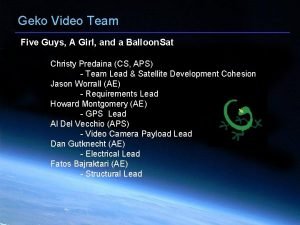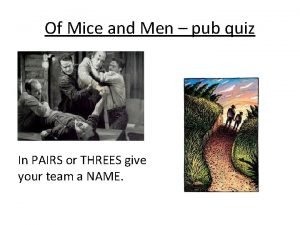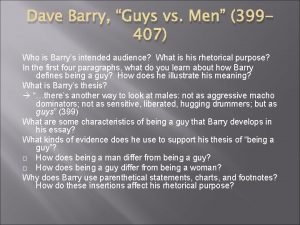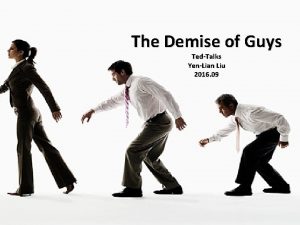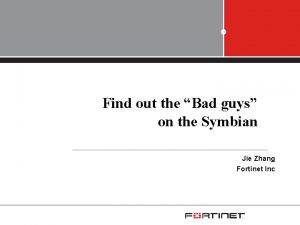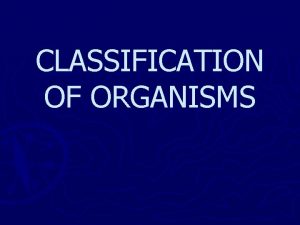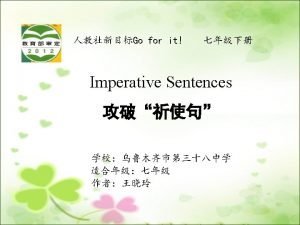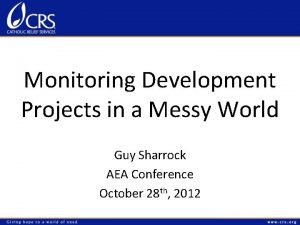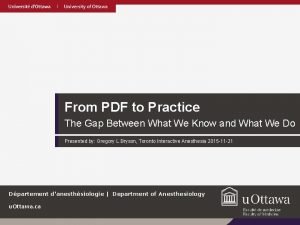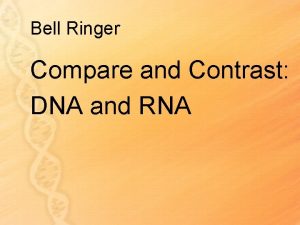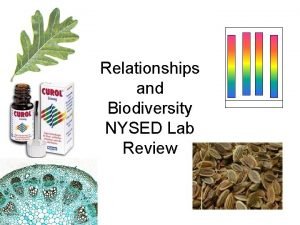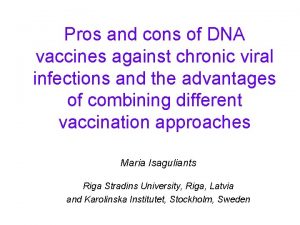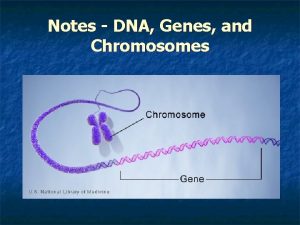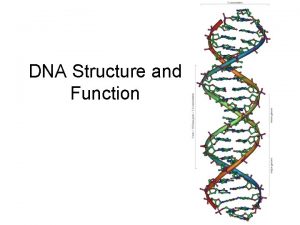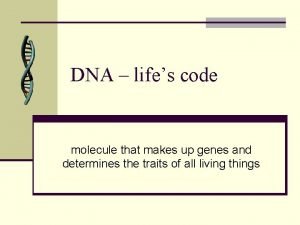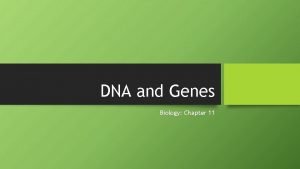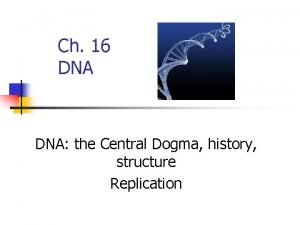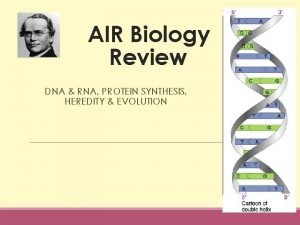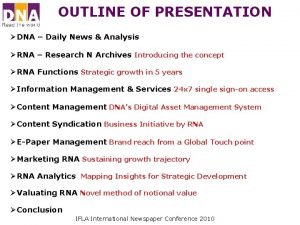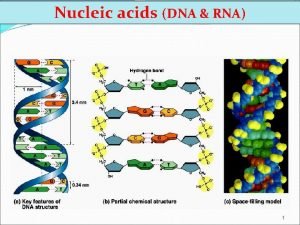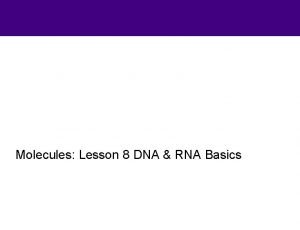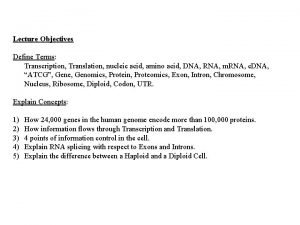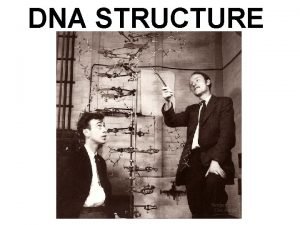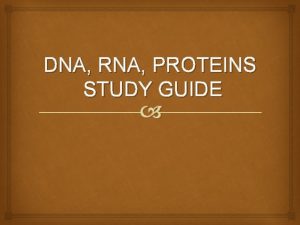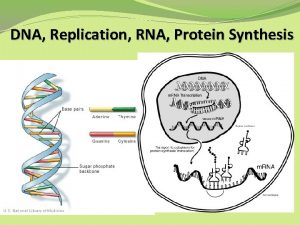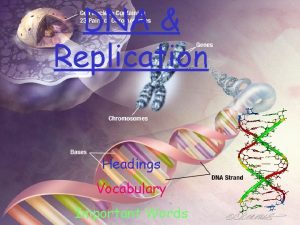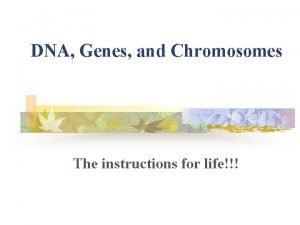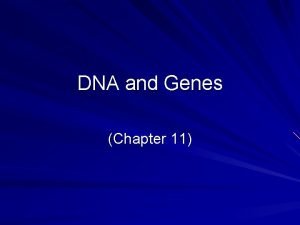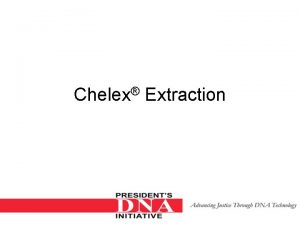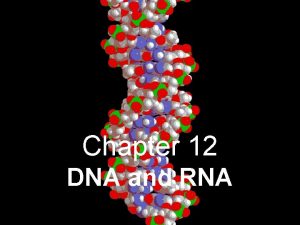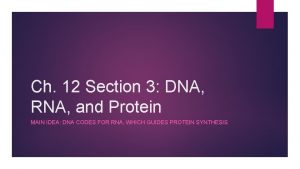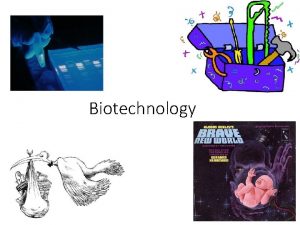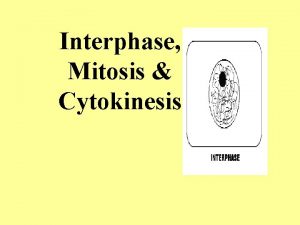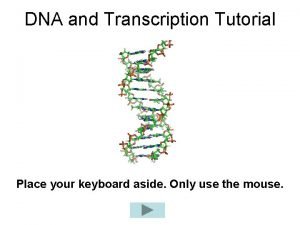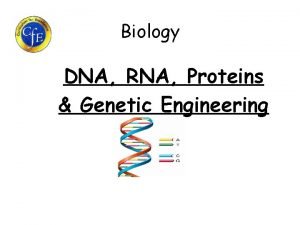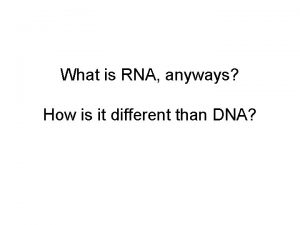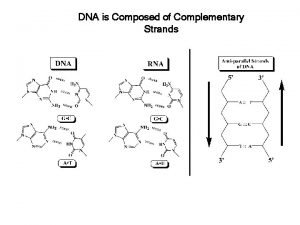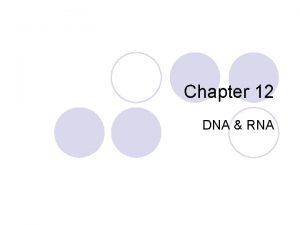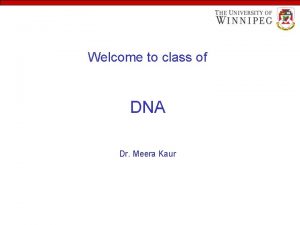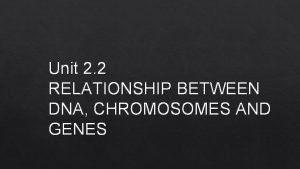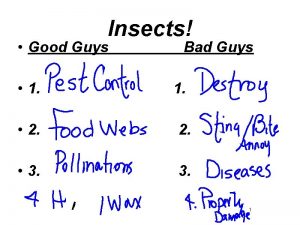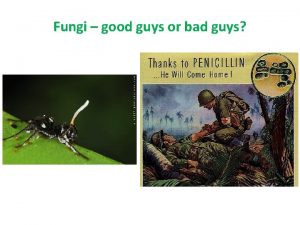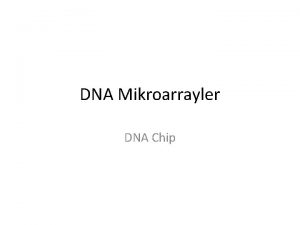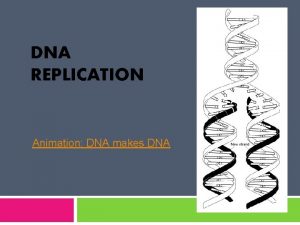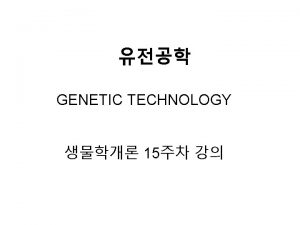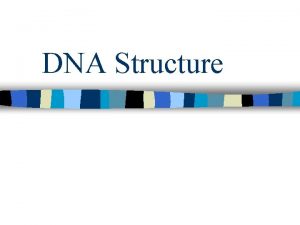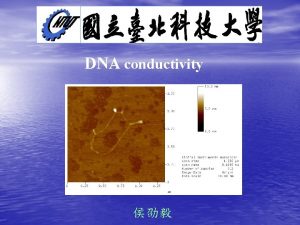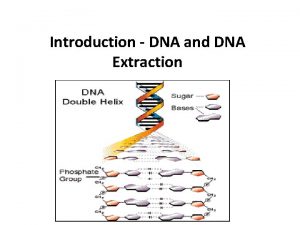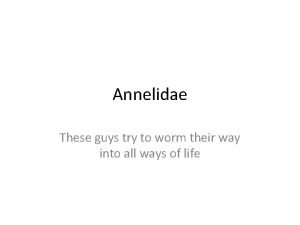DNA 5 Who are these guys And how




































































- Slides: 68

DNA (5)

Who are these guys? And how is DNA important in their lives?

A NYC Case Example

Sexual Assault in Building Hallway

Blood-soaked victim's shirt




Case Facts: • Person seen running from scene • ID of person made by tenant • Police arrest suspect • Suspect found to have prior history of sexual assault • Suspect confesses • Rape kit is negative for semen

DNA Testing Results • Blood stains on stairs do not match suspect • Local DNA database found a match with a semen stain from another case • Similar modus operandi and nearby location • Suspect identified in other case • DNA match with semen of other case

Did suspect have an accomplice?

Epilogue • Mixtures of DNA from victim and perpetrator found in bloodstain from victim’s clothing • Suspect’s DNA not found on clothing or crime scene • Charges dropped against suspect

What is DNA?

Functions of DNA 1. To transmit information from one generation of cells to the next 2. To provide the information for the synthesis of components (proteins) necessary for cellular function


What does DNA look like?


Chromosomes • In most types of cells, genetic information is organized into structures called chromosomes – 1 pair of sex chromosomes – 22 pairs of autosomes in humans

Chromosomes • Each chromosome has a single molecule of DNA bound to Histones – if fully extended the molecule would be about 1. 7 meters long – unwrapping all the DNA in all your cells • cover the distance from earth to moon 6, 000 times

Genes • Each chromosome contains hundreds to thousands information blocks called genes • Each gene is the blueprint for a specific type of protein in the body – only identical twins will have all the genes identical

What is DNA made of?

Nucleotides • DNA is a polymer built from monomers called nucleotides • Each nucleotide is consists of – deoxyribose • pentose sugar – phosphoric acid – a nitrogenous base

The DNA Backbone • The monomers are linked together by phosphodiester bridges (bonds) – links the 3’ carbon in the deoxyribose of one nucleotide to the 5’ carbon in the deoxyribose of the adjacent nucleotide

The DNA Double Helix • DNA is normally a double stranded macromolecule • Two polynucleotide chains are held together by H-bonding – A always pairs with T – C always pairs with G

Base Pairing of DNA Strands Hydrogen bonds 3’ 5’ A=T G C hybridized strands Phosphate-sugar T=A backbone C G A=T A T G C C denatured G C 5’ strands 3’G 5’ A=T G C T=A C G A=T T=A C G 3’ 5’ G C 3’

5’ T-T-G-A-C-T-A-T-C-C-A-G-A-T-C 3’ 3’ A-A-C-T-G-A-T-A-G-G-T-C-T-A-G 5’ In a double helix the strands go in opposite directions

Sources of DNA Blood and blood stains Semen and semen stains Bones Teeth Hair with roots Hair shaft Saliva (containing nucleated cells) Urine Feces Debris from fingernail scrapings Muscle Tissue Cigarette butts Postage stamps Envelope sealing flaps Dandruff Fingerprints Personal Items: razor blade, chewing gum, toothbrush, lipstick stains Adopted from Butler, J. M. (2001) Forensic DNA Typing, Table 3. 1, ©Academic Press

Where are the types of DNA found in a cell? Cell Nuclear DNA Mitochondrial DNA

DNA BASICS • Genomic DNA as hereditary material -found in the nucleus of the cell (nuclear DNA) • Determines physical characteristics of people • Half the DNA is maternal/half the DNA is paternal

DNA BASICS Genomic DNA is found in every nucleic cell in the body Genomic DNA is the same in all cells Genomic DNA does not change throughout one’s lifetime

DNA BASICS • No two people (except identical twins) have exactly the same DNA -not really true about twins… • DNA doesn’t change over time • Can get DNA from any cell • Mostly the same between people, but small regions vary between individuals • Less than 0. 1% of DNA is unique

What we can’t tell from forensic DNA testing…. . • • When it was left at scene Race- (now we can!) Age of person Diseases (unless genetic!) • How it got there (ex. Rape vs. Concentual sex)

DNA Extraction Organic Method Blood stain INCUBATE (56 o. C) SDS, DTT, EDTA and Centrifuge proteinase K VORTEX Centrifuge Phenol, chloroform, isoamyl alcohol TRANSFER aqueous (upper) phase to new tube TE buffer CONCENTRATE sample (Centricon/Microcon-100 or ethanol precipitation) Centrifuge QUANTIFY DNA PERFORM PCR

Differential Isolation of DNA Semen stain Remove Epithelial DNA Epithelial. Chemical DNA Different Chemical. DNA Sperm DNA

Amplification (making copies) Solution DNA

PCR • Polymerase Chain Reaction=Simulated Natural DNA replication • Copy sections of DNA. Not the whole DNA molecule

PCR

“DENATURE” Step one of a single cycle A T G C A T T A A T G C A G A T A G Heat T C T A T C

“ANNEAL” Step two of a single cycle A G T T C T A A T C T

“EXTEND” Step three of a single cycle A G A T T A T C T A A G T G A T C T G GA T G A T A G C T A T

Thermal Cycling Temperatures Temperature 94 o. C 72 o. C 60 o. C Single Cycle Time Typically 25 -35 cycles performed during PCR 94 o. C - Denaturation 60 o. C - Annealing 72 o. C - Extension

Number of Target Molecules Created Cycle Number 1 2 3 4 5 6 7 8 9 10 11 12 13 14 15 16 17 18 19 20 21 22 23 24 25 26 27 28 29 30 31 32 Number of Double-stranded Target Molecules 0 0 2 4 8 16 32 64 128 256 512 1024 2048 4096 8192 16, 384 32, 768 65, 536 131, 072 262, 144 524, 288 1, 048, 576 2, 097, 152 4, 194, 304 8, 388, 608 16, 777, 216 33, 544, 432 67, 108, 864 134, 217, 728 268, 435, 456 536, 870, 912 1, 073, 741, 824

Advantages of PCR • Need very small amounts of biological material – Minute amounts of DNA template may be used (i. e. , 3 u. L whole blood, 2 -3 mm bloodstain cutting) • Can be used with forensic samples – DNA degraded to fragments only a few hundred base pairs in length can serve as effective templates for amplification. • Contaminant DNA, such as fungal and bacterial sources, will not amplify because human-specific primers are used.

Now the fun begins!-Whose DNA is it?

Why we do analyze DNA? 1. Forensic cases -- matching suspect with evidence 2. Paternity testing -- identifying father 3. Historical investigations-Czar Nicholas, Jesse James, Genealogy 4. Missing persons investigations 5. Mass disasters -- putting pieces back together 6. Military DNA “dog tag” 7. Convicted felon DNA databases

Challenges of DNA Analysis • Mixtures of DNA must be resolved (ie. separated) • DNA could be degraded • There could be contaminants that interfere with PCR

How do we compare DNA?

1980 s-RFLP Technique (PCR not readily available)

What are the probes looking for? Variable Number Tandem Repeats (VNTR) • can contain anywhere from 20 to 200 base pairs • In Intron Region of DNA (-not Exon Region) • Inherited from mom and dad

After probing electrophoresis products

Real RFLP Analysis • Measurements taken of fragments that vary in length across people (length polymorphism) because they contain VNTRs

Problems with RFLP (Restriction Fragment Length Polymorphism) • Need a lot of DNA • Takes a long time to process the DNA (ie. 12 -14 weeks) • Sensitive to contamination

Late 1990 s PCR-STR Technique • Benefits: – Results in 2 -3 days (-but in real world, results not back for 6 -10 weeks because of workload) – Small DNA sample needed – Very specific-not affected by contaminants

STR (Short Tandem Repeats)

STRs • On Chromosome 5, there’s a repeat region called CSF 1 PO. At this site, the sequence “AGAT” is repeated. • For one person it might be repeated 7 times: …AGATAGATAGATAGA T… • while for others it might be repeated 5 times: • …AGATAGATAGAT…

Short Tandem Repeats (STRs) Fluorescent dye tags AATG 7 repeats 8 repeats the repeat region is variable between samples while the flanking regions where PCR primers bind are constant Primer positions define PCR product size

STR DNA Analyzer DNA Profile Amplified DNA

DNA Fingerprint

Mitochondrial DNA q. What is mt. DNA Typing? Circular like bacteria

Benefits at looking at m. DNA • More resistant to decay • Lasts longer than genomic DNA • Many copies

Advances in DNA Fingerprinting CODIS DNA Chips Geotracking

FBI’s CODIS DNA Database Combined DNA Index System • Used for linking serial crimes and unsolved cases with repeat offenders • Launched October 1998 • Links all 50 states • Requires >4 RFLP markers and/or 13 core STR markers • Current backlog of >600, 000 samples

Cold Hits and Solved Cases On August 25, 1979, an 8 -year old girl was brutally raped and murdered in San Pablo, CA. Semen was collected from the body and placed in an evidence room, where it sat for 22 years. Through this program, a DNA profile was made and submitted to the state and federal databases. This resulted in a “cold hit” identifying Joseph Cordova Jr. as the suspect. Cordova was a habitual child molester who at the time of the DNA analysis was incarcerated in a Colorado prison. Cordova was subsequently charged with molesting, raping and murdering the 8 -year old girl.

On November 8, 2000, a 12 year old girl, was kidnapped off of the street in Rancho Cordova, CA, and driven to Feather River in Sutter County where she was sexually assaulted and then killed. Nine months later, Justin Weinberger was stopped for a traffic violation in New Mexico. A check by police revealed that Weinberger was wanted on a federal warrant for child pornography. He was detained and voluntarily provided a DNA sample. Analysis of that DNA sample resulted in a match with evidence identifying Weinberger as the suspect in this case. Weinberger was subsequently extradited to California where he was tried and convicted of the murder of the 12 -year old girl.


STR Analysis by Hybridization on Microchips

Geo-Tracking DNA 1. 2. 3. 4. Missile cache found by CIA in Pakistan Swab packaging from outside to inside Obtain human, insect, fungal, plant DNA Analysis of DNA alone determined: a. shipment originated in Syria b. Stayed in Iran c. Then came to Pakistan

Brief Historical Review of DNA Typing • 1980 - Ray White describes first polymorphic RFLP marker • 1985 - Alec Jeffreys discovers multilocus VNTR probes • 1985 - first paper on PCR • 1988 - FBI starts DNA casework • 1991 - first STR paper • 1995 - FSS starts UK DNA database • 1998 - FBI launches CODIS database
 Mikael ferm
Mikael ferm Coding dna and non coding dna
Coding dna and non coding dna When do boys start growing pubic hair
When do boys start growing pubic hair Geko girl
Geko girl Replication
Replication Bioflix activity dna replication lagging strand synthesis
Bioflix activity dna replication lagging strand synthesis What are the enzymes involved in dna replication
What are the enzymes involved in dna replication Dna rna protein synthesis homework #2 dna replication
Dna rna protein synthesis homework #2 dna replication Curley's like a lot of little guys
Curley's like a lot of little guys Oggetti
Oggetti Hello my name is andrea
Hello my name is andrea Guys vs men by dave barry
Guys vs men by dave barry A schoolyard contains only bicycles and 4 wheeled wagons
A schoolyard contains only bicycles and 4 wheeled wagons Welcome guys
Welcome guys Ted talk the demise of guys
Ted talk the demise of guys Missing dollar riddle
Missing dollar riddle Bad guys mdl
Bad guys mdl Two guys from andromeda
Two guys from andromeda Kings play chess on fat guys stomachs
Kings play chess on fat guys stomachs Hello let me introduce myself song
Hello let me introduce myself song Wize guys
Wize guys The market guys
The market guys Open your books please
Open your books please Hold on guys
Hold on guys Messyworld guys
Messyworld guys Endo guys ottawa
Endo guys ottawa What is a summary flocabulary
What is a summary flocabulary Compare and contrast dna and rna.
Compare and contrast dna and rna. Difference between dna and rna
Difference between dna and rna Forms of dna
Forms of dna Transcription and translation coloring
Transcription and translation coloring Curol definition
Curol definition Virulent
Virulent Chromosome vs dna vs gene
Chromosome vs dna vs gene Dna primase
Dna primase Multiple choice questions on dna structure and replication
Multiple choice questions on dna structure and replication Dna polymer and monomer
Dna polymer and monomer Dna and rna concept map
Dna and rna concept map Chapter 11 dna and genes
Chapter 11 dna and genes What does 5' and 3' mean in dna
What does 5' and 3' mean in dna Venn diagram of transcription and translation
Venn diagram of transcription and translation Nn
Nn Dna double helix coloring worksheet answer key
Dna double helix coloring worksheet answer key Protein synthesis
Protein synthesis Dna daily news analysis
Dna daily news analysis Nucleic acid
Nucleic acid Dna and rna
Dna and rna Dna transcription and translation
Dna transcription and translation Why is dna a polymer
Why is dna a polymer Dna rna and proteins study guide answers
Dna rna and proteins study guide answers Difference between dna and rna extraction
Difference between dna and rna extraction Lenine
Lenine Building vocabulary: the nucleus, dna, and chromosomes
Building vocabulary: the nucleus, dna, and chromosomes Dna, genes and chromosomes relationship
Dna, genes and chromosomes relationship Dna and genes chapter 11
Dna and genes chapter 11 Chelex dna extraction advantages and disadvantages
Chelex dna extraction advantages and disadvantages Chapter 12 dna and rna
Chapter 12 dna and rna Chapter 12 section 3 dna rna and protein
Chapter 12 section 3 dna rna and protein Which career combines dna technology and forensics
Which career combines dna technology and forensics Dna replication transcription and translation
Dna replication transcription and translation Interphase to cytokinesis
Interphase to cytokinesis Dna protein synthesis study guide answers
Dna protein synthesis study guide answers Dna and transcription tutorial
Dna and transcription tutorial Dna and rna
Dna and rna Nucleotide
Nucleotide Major minor groove
Major minor groove Section 12-1 dna
Section 12-1 dna Watson crick model of dna
Watson crick model of dna What is the relationship between dna chromosomes and genes
What is the relationship between dna chromosomes and genes



